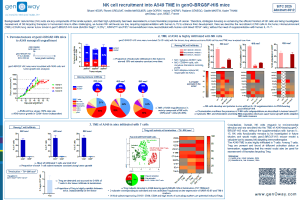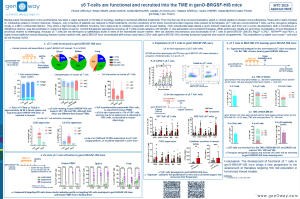Anti-VISTA agents profiling: complementarity of BRGSF-HIS and hVISTA Knock-in as preclinical models for immunotherapies
BRGSF-HIS & hVISTA for immunotherapies
The selection of relevant preclinical models which most closely resemble human tumor biology has considerable potential to ensure better prediction in preclinical studies.
LATEST UPDATE, June 2023: The strategy of using both the humanized ICP Vista model and genOway's immunodeficient BRGSF-HIS model enabled the Sensei Biotherapeutics team to effectively validate the therapeutic interest of the SNS-101 molecule and obtain FDA IND (Investigational New Drug Applications) approval in just 2 years. Following this approval in April 2023, Sensei Biotherapeutics announced in June that a first patient had received his first dose of treatment.
During the preclinical tests for the assessment of its drug candidate, Sensei Bio used genOway’s preclinical models. These models allowed it to better qualify its anti-VISTA antibody SNS-101, in terms of pharmacology, pharmacokinetics and toxicology. Please take a look at this article to see how our models helped it advance its pre-clinical testing.
Previous anti-VISTA therapeutics showed early stop in clinics and were associated to side effects such as cytokine release syndrome (CRS). Johnston et al., 20191 report that VISTA binds PSGL-1 and suppresses T cells selectively at acidic pH such as that found in tumor microenvironments. Therefore, VISTA targeting may represent a promising therapeutic approach for cancer. Researchers found that antibodies engineered to selectively bind and block PSGL-1-VISTA interaction in acidic environments were effective to reverse VISTA-mediated immune suppression in vivo.
The SNS-101, a pH selective anti-VISTA antibody developed by Sensei Bio
In summary, Sensei Bio’ study attests to the relevance of genOway’s preclinical models to:
- Test the efficacy of anti-VISTA antibodies
- Assess the toxicity of anti-VISTA antibodies and to minimize cytokine release syndrome in clinical testing
- Benchmark new antibodies and select those that are interesting to test in the clinical phase
On the basis of these different data, Sensei Bio developed a new human monoclonal IgG1 pH-sensitive antibody (named SNS-101), specific for the protonated, active form of VISTA.
After checking the inhibitory potential of SNS-101 on the binding of VISTA with its partners (PSGL-1, VSIG-3 and LRIG-1) at low pH, Edward van der Horst et al. tested the probability that their compound would induce a CRS, what was observed with first generation of anti-VISTA. CRS risk was first evaluated using circulating fresh human whole blood. The toxicity of SNS-101 was also evaluated in a preclinical model expressing human myeloid and lymphoid cells, BRGFS-HIS mouse, to enable a more translatable investigation. While OKT3, an anti-CD3 antibody, and JNJ, a pH non-selective anti-VISTA antibody, induced cytokine release in BRGSF-HIS mice, dose-dependent injections of SNS-101 antibody did not cause any significant induction of cytokines.
In a second step, the researchers assessed the efficacy of their immuno-oncology compound in the immunocompetent humanized VISTA mouse. These preclinical models represent a powerful model system for studying how compounds modulate immune cell response in a physiological microenvironment, because interaction of tumors with their microenvironment and with immune cells is fully functional.

Through PK studies in non-human primates, Edward von der Horst et al. also demonstrated that the pH-sensitive binding of SNS-101 avoids the rapid clearance by target mediated drug disposition (TMDD) that has been observed with non-pH-sensitive VISTA antibodies.
In MN49 tumor-bearing VISTA-KI mice, SNS-101 treatment induced a significant tumor growth inhibition 21 days after injection. This inhibitory effect was enhanced when anti-VISTA SNS-101 antibody was combined with the anti-PD-1 antibody.
Taken together, all these results from Sensei Bio demonstrate that anti-VISTA SNS-101 can abrogate TMDD and lower cytokine releasing syndrome (CRS) risk, while significantly enhancing the anti-tumor effects of PD-1 blockade. Interestingly, the work performed by Sensei Bio illustrates the complementarity of different preclinical models in answering specific scientific questions.
⇒ To learn more about our preclinical models, please feel free to contact us
⇒ To know more about SNS-101, please click here
References
- Robert J Johnston, Linhui Julie Su, Jason Pinckney, David Critton, Eric Boyer, Arathi Krishnakumar, Martin Corbett, Rose Dibella, Lynne Campbell, Gaelle H Martin, Hadia Lemar, Thomas Cayton, Richard Y-C Huang, Xiaodi Deng, Akbar Nayeem, Haibin Chen, Burce Ergel, Joseph M Rizzo, Aaron P Yamniuk, Sanjib Dutta, Justine Ngo, Andrea Olga Shorts, Radha Ramakrishnan, Alexander Kozhich, Jim Holloway, Hua Fang, Ying-Kai Wang, Zheng Yang, Kader Thiam, Ginger Rakestraw, Arvind Rajpal, Paul Sheppard, Michael Quigley, Keith S Bahjat, Alan J Korman. (2019). VISTA is an acidic pH-selective ligand for PSGL-1. Nature, 574(7779):565-570
Related products
Catalogue product
Customized product

Scientific excellence
From model design to experimental results
Featured in 600+ scientific articles

Collaborative approach
Collaboration with 17 Top Pharmas,
170+ Biotechs and 380+ Academic Institutions

Robust validation data on catalog models
Generated with biopharma partners and in-house

Innovative technologies
and guaranteed freedom to operate

Easy access to models
Models with certified health status from professional breeders in US and Europe




.webp)






























